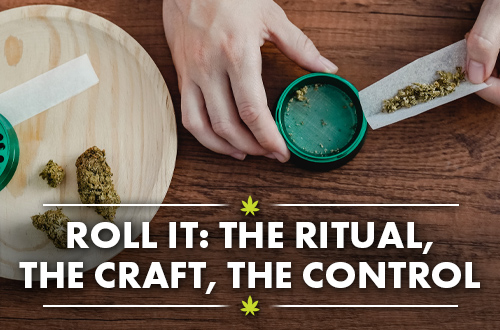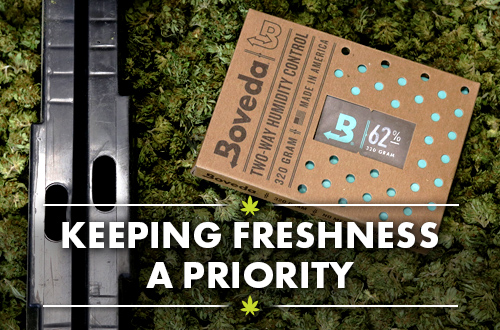Home Grow chronicles Dianna’s personal journey as a medical cannabis patient who registered and was approved by the Canadian government to grow cannabis in her home. Dianna’s experience is one grower’s point of view. Her ideas are neither the best or only proven methods for growing medicinal grade cannabis.
Weeds. They proliferate quickly. (Isn’t that right, Creeping Charlie?!) Holds true for cannabis, which could be how it earned the nickname weed. Boveda blogger Dianna Donnelly’s home grow is in the midst of a growth spurt. Within 10 days of their arrival, Dianna’s girls needed to be moved to bigger pots. (Pot. Is that how cannabis earned its other handle?) Let’s catch up with Di to see what to do when your cannabis clones are root bound.
LEG UP, NOT LEGGY: Clones Versus Seeds

In my 40+ years as a tree hugger, I’ve transplanted many types of plants. As I gingerly hold the lower stock of each cannabis plant to inspect the roots, the lifeforce feels strong in my hands.
Each plant is the shape of a perfect little Christmas tree. The branches are uniformly strong and close together. Now I understand the difference between growing from seed and growing from clone.
Previously, when I’ve planted from seed, the seedlings tend to stretch. After four weeks, my from-seed plants have had only three sets of branches and were really leggy.
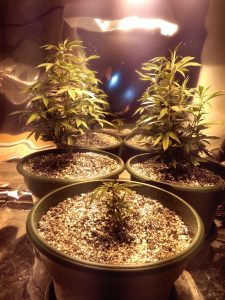
When my clones arrived, the approximately two-week-old plants had already powered through those awkward, overly fragile germination and seedling stages. In less than two weeks, my clones had more than a dozen branches that were all fighting for room to grow. These tree-like plants were so much sturdier than those nearby four-week-old plants I’d started from seed.
Re-planting my VEGGING cannabis clones
My horticulture is performed in a spare bedroom.
To keep things tidy, I mix and store my soil in a large Tupperware® container. My special soil recipe? Moistened sphagnum, perlite and vermiculite.
As a gardener, I plan my grow medium well. It’s where my girls eat, sleep, live and breathe. This snugly packed soil supports the roots while challenging each plant to grow. From this healthy soil roots seek moisture and growth-stimulating nutrients. Within hours, those newly transplanted roots will begin to investigate the new soil, as if they are the brain of the plant.
Using the lid as a work space, my process looks like this:
- DO NOT WATER PLANTS RIGHT BEFORE YOU TRANSPLANT THEM. A dryer root area will hold together better than a moist one.
- Grasp the stalk firmly and tip the planter over. Then gently pull the plant out of its original pot from the cultivator. (See photo below.)
- Now that you can see what’s been “growing on” under the soil line, you can judge how much new soil mix you’ll need to add to the bottom of the new planter. In the bottom of the new planter, give the roots a good four to five inches of new soil to grow into.
- Before you introduce the little lady to her new planter, add a bit of water to the soil you put in the bottom of that new pot.
- Gently place the lower root area in the new planter and tuck new soil in around the sides. By “tuck,” I mean “swaddle.”(Like you’re gathering up a blanket of rich soil around your newborn cannabis plant.) The plant’s roots depend on this support for balance. In fact, a local legal producer revealed he will never move away from growing cannabis plants in soil. Plants require soil for stability, the cultivator said. (Wonder what the hydroponic, aquaponic and aeroponic growers think about that?)
- Leave about an inch from the top, so your pot won’t overflow when you water.
- Thoroughly water your newly transplanted cannabis plant.
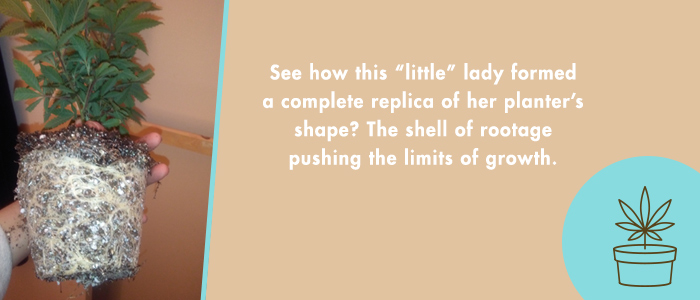
DIRT UNDER MY NAILS IS GOOD FOR ME
As I write, soil is still under my nails and it makes me chuckle. To some, soil is looked at as “dirty,” but green thumbs know better. To the plant, soil is everything—the beginning and the end, life given by death.
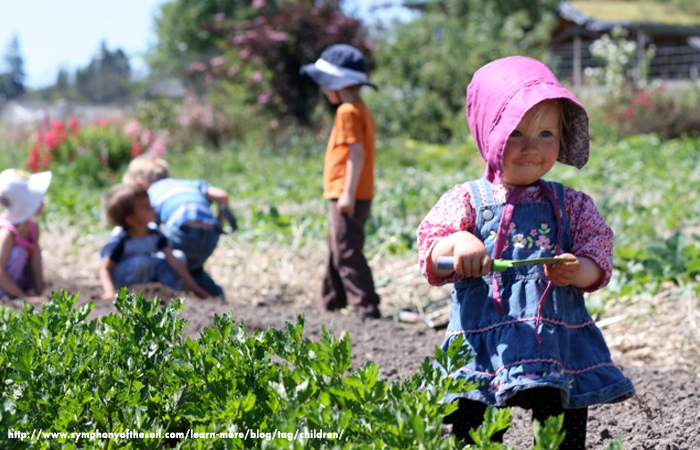
I’ve seen research that compares city-dwelling children to farm-dwelling children. One Finnish study found that children raised in the country are exposed to a larger array of friendly microbes, which may protect their bodies against allergies, asthma and other inflammatory diseases.
According to the “hygiene hypothesis,” cited by the U.S. Federal Drug Administration, “the problem with extremely clean environments is that they fail to provide the necessary exposure to germs required to “educate” the immune system so it can learn to launch its defense responses to infectious organisms.”
So see, a little dirt is good for us.
TIPS FOR WATERING CANNABIS PLANTS

Like so many aspects of gardening, when and how to water your cannabis plants is subjective.
Should a home grower water:
- From the top or the bottom?
- Daily or every other day?
- Morning or evening?
- With distilled or tap water?
My own research on watering a home grow has turned up as many opinions as there are cannabis strains. No two experiences are alike, so it’s no wonder even degree-wielding botanists disagree on what’s best.
Me? I use common sense when it comes to watering. I leave tap water out overnight, so it can come to room temperature.
Did I test the pH level of the water I use for my cannabis plants?
No, I haven’t bothered with testing the pH level of my water because my plants are thriving.
Many growers test the pH or “potential hydrogen” of their water to measure how acidic or alkaline it is. Every living organism is sensitive to and thrives at a certain point on the pH scale, which ranges from 1 (very acidic) to 11 (very basic).
Cannabis plants prefer a mid-measurement between 5.5 and 6.5 pH. Water that falls above or below this pH range may not properly nourish a cannabis plant.
1 TO 14 DAYS AFTER TRANSPLANTING:
I begin by watering about a cup per plant from the top every other day. This lets those freshly transplanted roots adjust to the move and gives them time to spread out in their new digs.
14 DAYS BEYOND TRANSPLANTING:
I switch to watering my cannabis plants from the bottom. Those roots are now good and well-rooted. Watering from the bottom encourages and demands those roots seek water to produce great yields.
As gardeners say, “More root, more fruit!”
TIPS FOR FEEDING CANNABIS PLANTS
Feeding is a way that growers “humanize” their plants. As in our own nutrition, marketing convinces us that more is better. More protein! More vitamins! More water! More fiber! As such, many home growers feed their cannabis plants way too much. A botanist buddy of mine said that fertilizer manufacturers want to sell you more, so their feeding recommendations reflect that. When you use more, you buy more.
Now what to feed cannabis plants is yet another personal choice. Some growers find a product and stay loyal for life. Others experiment with every fertilizer on the market, while others make their own. (Compost tea, anyone?)
Other growers don’t even bother with adding nutrients to their soil. These folks believe that whatever microorganisms are present in the soil will satiate their plants. Usually these are the home growers who see equal value in the cannabis leaf and the flower. They juice raw cannabis leaves or just throw them into their salads. In this raw form, the cannabinoids have medicinal value but aren’t psychoactive. Although the therapeutics of cannabis greens have yet to be quantified, when has it ever been bad to eat your own home grown greens?
WHAT I FEED MY CANNABIS PLANTS
On the advice of my trusty botanist friend, I rely on a product line called Botanicare Pure Blend Pro®.
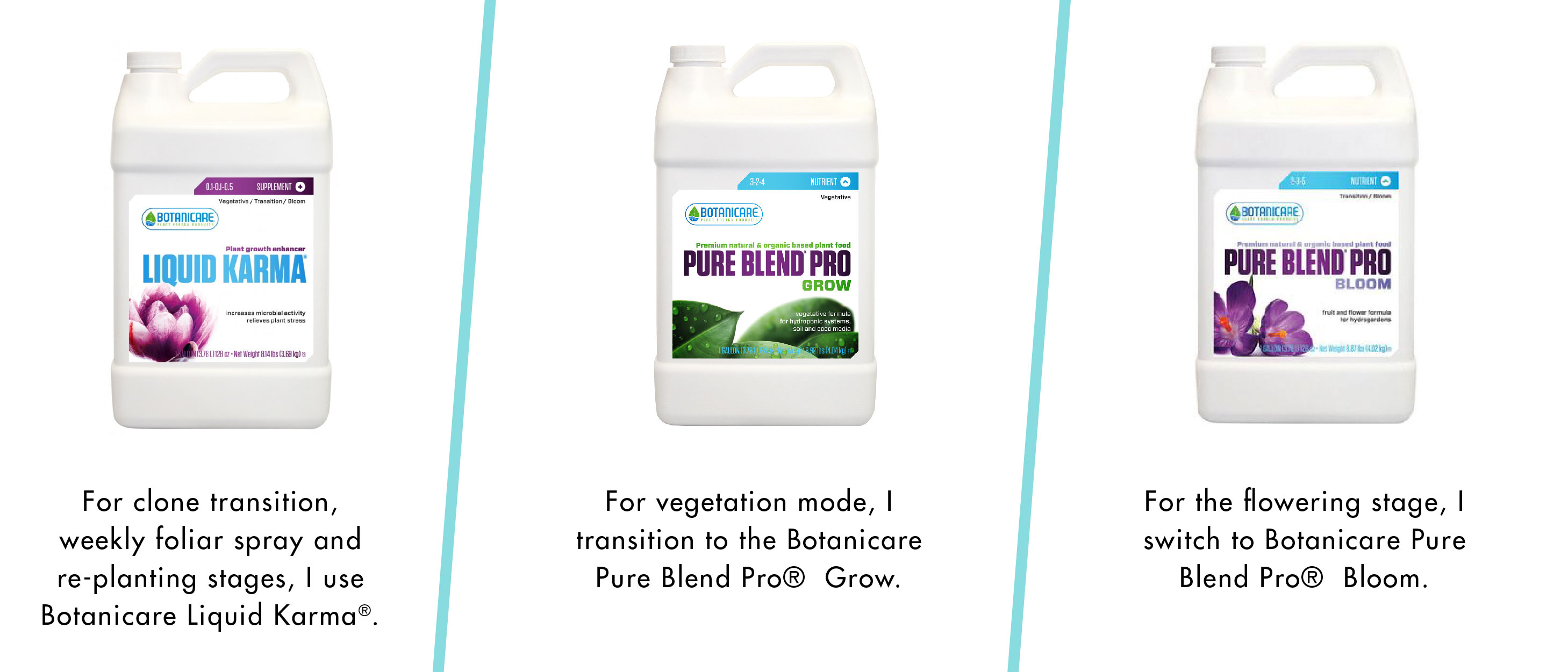
Transplanting my cannabis clones reminded me of the intangible benefits of tending to plants. Of course, growing my own medicinal cannabis will save me money, but it’s so much more than that. Gardening and growing anything feeds my soul. For me, gardening acts as an antidepressant. Every aspect of home growing is a hope for the future—something that depression often steals from me. I’m forced to be more present. To look forward, instead of into the past. It’s in the present and the future that I see my efforts manifest into life. Big, green bountiful life!
As I set my girls back under their sun, a calm falls over me. The pride of a million cannabis consumers fills my soul. I’m overflowing with gratitude. I thank the universe. Thank Canada’s Supreme Court. Thank the Creator for keeping me healthy and strong enough to be a caregiver to my cannabis. And thank my parents for teaching me how to be a good steward to the earth.

Dianna Donnelly is a cannabis educator, blogger, and freelance writer living in Kingston, Ontario. She counsels new patients on the safe and effective use of medicinal cannabis and believes that with enough time, cannabis, and coconut oil she can heal the world.
Dianna Donnelly’s posts are being provided for informational purposes only; they do not constitute an endorsement or an approval by Boveda of any of the products, services or opinions of Dianna Donnelly. Boveda bears no responsibility for the accuracy, legality or content of this post or links to the posts. Contact Dianna Donnelly for answers to questions regarding her content.
Home Grow #3: Clones Come Home
Home Grow #5: Topping & Cloning





